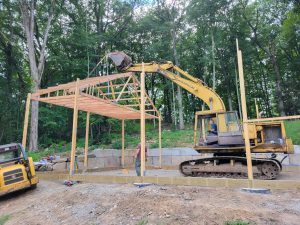What do you mean they are not 2 feet apart?
Back in the day (early 1990’s) I was on the National Frame Builders Association (NFBA) Board of Directors. One of my fellow board members from the Midwest wanted to take a peek at how pole barns were constructed in the West, so I invited him out for a tour.
After spending a day looking at several of our building projects, his comment to me was, “The inspectors in our area would never let a pole building be constructed with roof trusses placed every 12 feet”.
Twenty years later, I beg to differ. Hansen Buildings has buildings in each of the 50 states and all of them have roof trusses on what my board member friend would describe as being “widely spaced”.
Modern truss design is highly computerized. Enter the span of the truss, bay spacing and load conditions and the engineering programs will design a truss which will meet the design criteria. The lumber and steel plates the trusses are constructed from, have no idea how far apart they are going to be placed. They are inanimate! Yet, somewhere in the deep, dark reaches of history, lies the theory wood trusses must be spaced no more than 24” on center, or maybe 48”, or perhaps even eight or ten feet? The reality is, there is no magic number.

While D. Howard Doane is credited with being the innovator of the modern pole barn, it was his Agricultural Service farm manager, Bernon Perkins, who is credited with refining the evolution of the modern pole building to a long-lasting structure. It was Perkins who pioneered roof purlins being placed on edge. With this design change, roof trusses could be placed 12 feet apart, making it possible for roofs to support the loads to which they would be subjected.
I’ve had roof truss manufacturers try to convince me it is impossible to place wood trusses at spacings of over every 4 feet. Their defense is, “Our engineers will not allow us to”. The manufacturers of the steel roof truss plates (also referred to as gussets or Gang-nails), provide the engineering design for pre-fabricated wood trusses. Their programs will allow for trusses to be placed on 12 foot or even 16 foot centers, and their engineers will place their engineer’s seal on the drawings to verify.
The practicality, cost effectiveness and ease of construction of pole buildings is based upon efficient use of the fewest amount of materials, to do the most work, within safe engineering design. Hundreds of thousands of pole barns are in use today with trusses spaced every 12 feet, or even more. They stand as a tribute to the ingenuity of modern pole building design.






